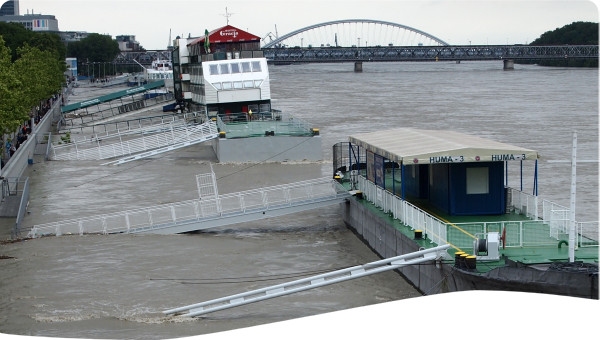Rapid urbanisation has led to widespread settlements of floodplains, resulting in widespread vulnerability of livelihoods. Since traditional approaches are no longer sufficient, a more integrated flood management approach was realised to adapt to changing social, hydrological, and environmental conditions along the nation’s major waterways. Furthermore, the Ministry of Water Resources prepared a national flood management strategy. The key to flood risk management is learning to live with flood risks.
China has traditionally relied on structural measures to control floods. However, as floodplains have become more densely settled due to population pressure, flood damage has raised, despite major public investment in structural flood control measures. Extremely rapid urbanization associated with economic development and migration from rural areas has seen populations in some cities triple or even quadruple within a decade, making it difficult for city planners to provide adequate infrastructure. Newcomers are often unfamiliar with past flooding history and they are unaware of the flood risk or simply have no choice, they have settled on flood-prone land. Cities have expanded into surrounding farmland where standards of flood protection are lower. Drainage systems in many city centers have become antiquated, while the value of assets and property at risk has escalated.
Advanced systems of flood control infrastructure exist for many large Chinese rivers. However, the standard of protection varies and investment is required to extend essential infrastructure to all large rivers and many tributaries of the major river basins. Many flood control structures were constructed in the 1950-60s, when standards of design, construction, and supervision were less rigorous than they are today. These structures are aging and may contain hidden defects.
Many large and medium-sized reservoirs have been rehabilitated under sustained government programs since the 1990s; however, serious dike failures have occurred during past floods, and disasters have often been prevented only by keen vigilance during emergencies and large-scale mobilization of labor for flood defense. Inappropriate land use management has been a shortcoming of past flood management in China due to the unprecedented pace of socioeconomic development and the increase in population densities. To apply land use planning as a flood management is required especially at local government level where most land use planning is practiced.
The traditional approach to flood control, which relied solely on structural measures, is no longer practically or economically feasible. A more integrated flood management approach was realized to be necessary to adapt to changing social, hydrological, and environmental conditions along the nation’s major waterways.
The government passed the Flood Control Law in 1997. In 2004, Asian Development Bank started to support preparation of a national flood management strategy. Hence, the Ministry of Water Resources prepared a national flood management strategy in 2005. This strategy reflects a shift from dependence on structural measures to a balanced approach using both structural and nonstructural measures. Now flood risk management is based on an analysis of flood hazard, exposure to flood hazard, and vulnerability of people and property to danger. This is followed by identification, assessment, and implementation of appropriate structural and nonstructural measures to manage or reduce flood risks to levels regarded as acceptable.
The Flood Control Law remains the centerpiece legislation supported by regulations guiding the implementation of flood management policies. Coupled with the legislations and regulations supported by the government, the River Basin Commissions are responsible in formulating plans for water resources management and flood control (flood management).
Management of land use in upper watersheds has also been added as one of the aspects of flood management which includes afforestation programs and programs to raise the awareness of the effects of inappropriate land use practices and to modify behavior in agricultural communities. Agricultural extension activities in rural areas have been instituted to explain to land users how improved practices can enhance and sustain their incomes while conserving soil fertility and soil moisture and reducing runoff and erosion.
The concept of flood risk and its management is the core of the strategic framework for flood management, but it is not the only aspect. The strategic framework also considers the institutional organization for management activity and the planning actions to mitigate flood risks. The framework also contains safeguards to mitigate the adverse social and environmental impacts and minimize the risks of unintended impacts.
Massive investments have been made in structural flood control measures to modify flood hazards in the PRC, and highly developed systems of flood control works now exist throughout the country. Structural flood control measures in the PRC currently comprise numerous reservoirs, dikes, river regulation works, and detention areas.
People and governments need to recognize that flood risks cannot be eliminated entirely. Instead, people should learn to accept some degree of the risks and, in return, derive benefits from flood ,sustenance of aquatic and riparian ecosystems.
Regardless of efficient measures, enforced resettlement is inevitable causing some dissatisfaction, disrupting the established social fabric of community life. In the rural communities, attachments to land led resettled drifted back to where they originated, despite official displeasure.
Vulnerability and the social consequences of flooding depend on prevailing economic conditions, housing, education, standard of governance, existing public infrastructure and services. These make communities more susceptible to the adverse impacts of flooding and reduce resilience from natural disasters.
The transition from flood control to IFM is challenging - demands raised awareness and changed consciousness about the role of nonstructural measures and the social and eco-environmental dimensions as well as new way of implementing IFM within organizational structures.
Planning and implementing local-scale flood mitigation in isolation leads to conflict and aggravation of flooding problems elsewhere. This may modify flood hazard and increase flood risk on the opposite bank.
 Case studies
Case studies
